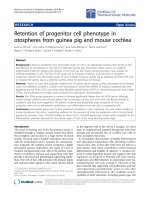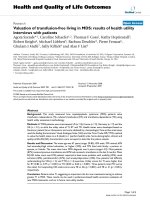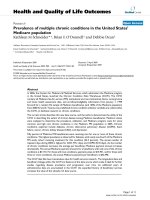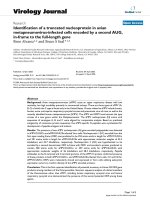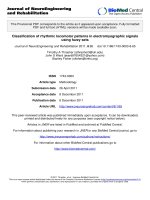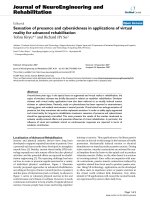báo cáo hóa học: " Participation of MCP-induced protein 1 in lipopolysaccharide preconditioning-induced ischemic stroke tolerance by regulating the expression of proinflammatory cytokines" pdf
Bạn đang xem bản rút gọn của tài liệu. Xem và tải ngay bản đầy đủ của tài liệu tại đây (1.25 MB, 38 trang )
This Provisional PDF corresponds to the article as it appeared upon acceptance. Fully formatted
PDF and full text (HTML) versions will be made available soon.
Participation of MCP-induced protein 1 in lipopolysaccharide
preconditioning-induced ischemic stroke tolerance by regulating the expression
of proinflammatory cytokines
Journal of Neuroinflammation 2011, 8:182 doi:10.1186/1742-2094-8-182
Jian Liang ()
Jing Wang ()
Yasser Saad ()
Logan Warble ()
Edilu Becerra ()
Pappachan E Kolattukudy ()
ISSN 1742-2094
Article type Research
Submission date 10 August 2011
Acceptance date 24 December 2011
Publication date 24 December 2011
Article URL />This peer-reviewed article was published immediately upon acceptance. It can be downloaded,
printed and distributed freely for any purposes (see copyright notice below).
Articles in JNI are listed in PubMed and archived at PubMed Central.
For information about publishing your research in JNI or any BioMed Central journal, go to
/>For information about other BioMed Central publications go to
/>Journal of Neuroinflammation
© 2011 Liang et al. ; licensee BioMed Central Ltd.
This is an open access article distributed under the terms of the Creative Commons Attribution License ( />which permits unrestricted use, distribution, and reproduction in any medium, provided the original work is properly cited.
1
Participation of MCP-induced protein 1 in lipopolysaccharide preconditioning-
induced ischemic stroke tolerance by regulating the expression of
proinflammatory cytokines
Jian Liang
1*
, Jing Wang
1
, Yasser Saad
1
, Logan Warble
1
, Edilu Becerra
1
, Pappachan E.
Kolattukudy
1
1
Burnett School of Biomedical Sciences, University of Central Florida College of Medicine,
4000 Central Florida Blvd. Orlando, FL 32816, USA
*Correspondence: (Jian Liang, M.D., Ph.D., Research Assistant Professor,
Burnett School of Biomedical Sciences, University of Central Florida College of Medicine,
4000 Central Florida Blvd. Orlando, FL 32816, USA)
2
Abstract
Background: Lipopolysaccharide (LPS) preconditioning-induced neuroprotection is known to
be related to suppression of the inflammatory response in the ischemic area. This study seeks
to determine if monocyte chemotactic protein–induced protein 1 (MCPIP1), a recently
identified CCCH Zn finger-containing protein, plays a role in focal brain ischemia and to
elucidate the mechanisms of LPS-induced ischemic brain tolerance.
Methods: Transcription and expression of MCPIP1 gene was monitored by qRT-PCR and
Western blot. Mouse microglia was prepared from cortices of C57BL/6 mouse brain and
primary human microglia was acquired from Clonexpress, Inc. Wild type and MCPIP1
knockout mice were treated with LPS (0.2 mg/kg) 24 hours before brain ischemia induced by
transient middle cerebral artery occlusion (MCAO). The infarct was measured by 2,3,5-
triphenyltetrazolium chloride (TTC) staining.
Results: MCPIP1 protein and mRNA levels significantly increased in both mouse and human
microglia and mouse brain undergoing LPS preconditioning. MCPIP1 mRNA level
significantly increased in mice ipsilateral brain than that of contralateral side after MCAO. The
mortality of MCPIP1 knockout mice was significantly higher than that of wild-type after
MCAO. MCPIP1 deficiency caused significant increase in the infarct volume compared with
wild type mice undergoing LPS preconditioning. MCPIP1 deficiency caused significant
upregulation of proinflammatory cytokines in mouse brain. Furthermore, MCPIP1 deficiency
increased c-Jun N terminal kinase (JNK) activation substantially. Inhibition of JNK signaling
decreased the production of proinflammatory cytokines in MCPIP1 knock out mice after
MCAO.
3
Conclusions: Our data indicate that absence of MCPIP1 exacerbates ischemic brain damage
by upregulation of proinflammatory cytokines and that MCPIP1 participates in LPS-induced
ischemic stroke tolerance.
Key Words: Ischemic stroke, lipopolysaccharide (LPS) preconditioning, monocyte
chemotactic protein–induced protein 1 (MCPIP1), middle cerebral artery occlusion (MCAO),
proinflammatory cytokines.
4
Background
Stroke is the second leading cause of death and the most frequent cause of permanent disability
worldwide [1]. Inflammatory mechanisms that are activated within hours after brain ischemia
represent a key target of current translational ischemic stroke research [2]. It has been reported
that the levels of proinflammatory cytokines and chemokines are increased after focal ischemia.
Chemokines are cytokines that have the ability to induce chemotaxis on neighboring cells,
particularly those involved in inflammatory actions [3, 4]. While some cytokines may offer
protection, many cytokines and most chemokines have been shown to participate in the
neuronal damage processes [4, 5]. Upregulation of cerebral proinflammatory cytokines,
activation of local microglia, astrocytes and systemic lymphocytes and invasion of leukocyte in
the brain contribute substantially to ischemic brain damage [6].
Published data have shown that lipopolysaccharide (LPS) preconditioning is a powerful
neuroprotective phenomenon by which a sublethal injurious stimulus renders the brain resistant
to a subsequent damaging ischemic insult [7-11]. LPS preconditioning-induced
neuroprotection is related to the suppression of the inflammatory response in the ischemic area
of the brain, but the mechanisms involved in LPS preconditioning are poorly understood [12,
13].
MCPIP1 (also known as ZC3H12A) is a recently identified protein in human peripheral blood
monocytes treated with monocyte chemotactic protein 1 (MCP-1) [14]. In our previous studies,
MCPIP1 was shown to be a negative regulator of macrophage activation [15]. Further
investigations by our group and others indicated that MCPIP1 can play a significant anti-
inflammatory role by inhibiting the generation of a set of major proinflammatory cytokines [16,
17]. MCPIP1 was also found to be inducibly expressed in monocytes, macrophages, and
5
endothelial cells with LPS stimulation [13, 17-19]. However, the role of MCPIP1 in ischemic
stroke has not been examined. In this study we examined MCPIP1 gene expression in human
and mouse microglia, and in mouse brain under LPS treatment or preconditioning. We also
examined MCPIP1 gene expression in mouse brain undergoing MCAO. We studied whether
there is loss of LPS preconditioning-induced ischemic stroke tolerance in MCPIP1 knockout
mice and whether such effects involve regulation of expression of proinflammatory cytokines.
Furthermore we investigated the effects of MCPIP1 on JNK signal pathway under brain
ischemia conditions and the effects of JNK inhibitor on the production of proinflammatory
cytokines in MCPIP1 knockout mice after brain ischemia. Our data indicate that MCPIP1 is
upregulated under LPS preconditioning or after brain ischemia stress and MCPIP1 participates
in LPS preconditioning-induced ischemic stroke tolerance by modulating gene expression of
proinflammatory cytokines.
Methods
Animals and LPS Preconditioning
MCPIP1 knockout mice were established as previously described [16]. Briefly, Mcpip1
-/-
mice
was generated by homologous recombination in embryonic stem cells from C57/BL6
background mice. Exons 3, 4, 5 and most part of 6 of mouse Mcpip1 were targeted with a
LacZ-neomycin cassette in embryonic stem cells established from C57/BL6 mice and
established Mcpip1
-/-
mice in pure C57/BL6 background. The deletion of MCPIP1 protein in
Mcpip
-/-
mice was confirmed by Immunoblotting. Six to eight-week-old mice were used. All
experimental procedures were approved by the Institutional Animal Care and Use Committee
of University of Central Florida. We performed all the experiments by using littermate mice.
6
For in vivo study mice were given an intraperitoneal injection of saline or LPS (Sigma, USA)
0.2mg/kg in saline 24 hours before transient middle cerebral artery occlusion (MCAO) [12].
Cell Cultures
Human microglia was acquired from Clonexpress, Inc. (Gaithersburg, MD, USA) and cultured
in 50:50 DMEM: F-12 supplemented with 10% FBS and 10 ng/ml of M-CSF, grown at 37ºC in
a humidified environment (5% CO
2
; 95% air). Mouse microglia cultures were generated by the
procedures described by Watson and colleagues [20]. In brief, mouse microglia was prepared
from cortices of C57BL/6 mouse brain. Brain tissue was placed in 2 ml Dulbecco’s modified
Eagle’s medium (DMEM; Invitrogen, USA) supplemented with 10% fetal bovine serum
(Gibco, USA), penicillin (100 U/ml; Gibco, USA) and streptomycin (100 U/ml; Gibco, USA).
Samples were triturated, passed through a sterile nylon mesh filter; centrifuged (1500 rpm, 5
min, 20-22ºC) and the pellets were resuspended in DMEM. Cells were grown in T25 flasks in
DMEM medium supplemented with 10% FBS. After 12 days the flasks were shaken for 2
hours at 110 rpm at room temperature and tapped several times to remove the non-adherent
microglia. The supernatant was centrifuged at 1500 rpm for 5 min and the pellet was
resuspended in normal DMEM medium mentioned above for experiments. LPS (Catalog #,
L4516, Sigma, USA) or PBS was added to medium (0.1µg/ml) for cell stimulus experiments.
Mouse Focal Brain Ischemia Reperfusion Model
For focal brain ischemia, mouse reversible middle cerebral artery occlusion (MCAO) was
produced by filament occlusion of the right MCA following a modification of the method
reported by Clark and colleagues [21]. In brief, mice were anesthetized with isoflurane
7
(induction with 3%; maintenance with 1.2%) in oxygen-enriched air by facemask, and rectal
temperature was controlled at 37 ±0.5°C throughout the experiment with heating lamps.
Unilateral MCAO was performed by inserting a 7-0 nylon monofilament into the internal
carotid artery via an external carotid artery stump and then positioning the filament tip for
occlusion at a distance of 8-9 mm beyond the internal carotid/pterygopalatine artery bifurcation.
MCA was occluded for 90 minutes followed by reperfusion.
Brain Infarction Measurement
The brains were stained with 2,3,5-triphenyltetrazolium chloride (TTC) ( Sigma, USA ) to
determine infarct volume [4,22]. After 90 min of MCAO and 48 hours of reperfusion, mice
were anesthetized with 4% isoflurane and brains were removed and sectioned coronally at a
thickness of 2mm and incubated in 2% TTC at 37 ºC for 20 minutes. Brain slices were then
fixed in 4% paraformaldehyde at 4ºC overnight and scanned into a computer, and quantified
using the Image J software. Infarct volume was expressed as a percentage of the contralateral
hemisphere. There were 10 mice in each group.
Brain Edema Measurement
The mice were anesthetized with 4% isoflurane and brains were removed at different time
points, i.e., 12, 24, and 48 h after MCAO. The brains were weighed to obtain the wet weight
and were then dried at 105 ºC for 24 h before measuring dry weight. Brain moisture content (%)
was calculated as follows, 100× (wet weight- dry weight)/wet weight. There were ten mice in
each group.
8
Quantitative Real-Time PCR
Quantitative Real Time-PCR was performed as previously described [15]. Briefly, Total RNA
was isolated using RNA STAT-60 reagent (TEL-TEST, INC. USA), after removing the
genomic DNA using DNase I (Ambion, USA), 2.0 ug of total RNA from microglia or mouse
brain tissue was reverse-transcribed to cDNA using a commercially available kit (Applied
Biosystems, USA). Quantitative real-time PCR was performed with iCycler Thermal Cycler
(Bio-Rad, USA) using 2 X SYBR Green master mixes (Bio-Rad, USA). Forty cycles were
conducted as follows: 95 °C for 30 s, 60 °C for 30 s, proceeded by 10 min at 95 °C for
polymerase activation. Quantification was performed by the delta cycle time method, with
mouse β-actin used for normalization. Human MCPIP1 gene specific primers (IDT, USA) were
F: 5´-GCCGGCGGCCTTA; R: 5´-GCACTGCTCACTCTCTGTTAGCA. The mouse specific
primers (IDT, USA) are as follows, MCPIP1: F: 5’-CCCCCTGACGACCCTTTAG; R: 5’-
GGCAGTGGTTTCTTACGAAGGA, TNFα: F: 5’- CTGAGGTCAATCTGCCCAAGTAC; R:
5’-CTTCACAGAGCAATGACTCCAAAG, IL-1β: F: 5’- GCCCATCCTCTGTGACTCAT; R:
5’- AGGCCACAGGTATTTTGTCG, IL-6: F: 5’- TCGTGGAAATGAGAAAAGAGTTG; R:
5’- AGTGCATCATCGTTGTTCATACA, MCP-1: F: 5’- CCATCTCTGACCTGCTCTTCCT;
R: - AGACCCACTCATTTGCAGCAT, β-actin: F: 5’- AAATCGTGCGTGACATCAAAGA;
R: 5’- GGCCATCTCCTGCTCGAA.
Western Blot
Western blot was performed as previously described [15]. Proteins from microglia or mouse
brain tissue were extracted and concentrations were determined by the Bradford method (Bio-
Rad, USA) with bovine serum albumin as the standard. Proteins (50ug) were separated by
9
SDS-PAGE and transferred onto nitrocellulose membranes in transfer buffer containing 0.1%
SDS. The membranes were blocked with 5% nonfat dry milk in 0.05% Tween 20 in Tris-
buffered saline (TTBS) for 2 h and incubated with the primary antibodies against MCPIP1
(Catalog #, sc136750, Santa Cruz, USA), phosphor-SAPK/JNK ( Catalog #, 9251, Cell
Signaling, USA ), SAPK/JNK ( Catalog #, 9252, Cell Signaling, USA ), phosphor-c-jun
( Catalog #, 2361, Cell Signaling, USA ), c-jun ( Catalog #, 2315, Cell Signaling, USA ) at a
1:1000 dilution in the blocking buffer, 4ºC, gently shaking, overnight. After being washed with
TTBS three times for 10 min each, the membranes were incubated with a 1:2,000 dilution of
secondary antibody (Santa Cruz, USA) in TTBS for 1 h. Following three 10-min washes with
TTBS, membranes were incubated with SuperSignal West Pico Chemiluminescent Substrate
(Pierce, USA) and exposed to x-ray film. The intensity of bands was quantified by AlphaImage
2200 (AlphaInnotech, USA). The ratios between interested protein bands and the loading
control (β-actin, total JNK or c-jun) were calculated and the data are expressed as the
normalized folds with respect to sham.
Drug Administration
JNK specific inhibitor SP600125 (Sigma, USA) was dissolved in PPCES vehicle (30%
polyethylene glycol–400/20% polypropylene glycol/15% cremophor EL/5% ethanol/30%
saline) as reported [23] and was treated by mice tail-vein injection 1h before ischemia at a
dose of 15 mg/kg.
10
Statistical Analysis
The data are presented as mean ± SD. Multiple comparisons were evaluated by one-way
ANOVA followed by the Tukey or Dunnett test. Two-group comparisons were analyzed by the
2-tailed Student t test. For all analyses, a value of P<0.05 was considered significant.
Results
MCPIP1 Induction in Mouse and Human Microglia by LPS Treatment
In ischemic stroke, microglia is activated after brain ischemia and release inflammatory
cytokines that exacerbate brain injury. We examined whether LPS induces MCPIP1 in mouse
microglia. The MCPIP1 mRNA level in mouse microglia was significantly induced by LPS
( 0.1µg/ml ) treatment compared to PBS controls; significant increase of MCPIP1 in transcript
level was detected at 3h and reached 11.12±1.63 fold at 24h after LPS treatment ( P<0.001;
Figure 1A ). Consistently, the MCPIP1 protein levels in mouse microglia were significantly
higher in LPS (0.1µg/ml ) treated cells than in the controls, 5.93±0.72 fold on 24h after LPS
treatment (P<0.05; Figure 1B). The MCPIP1 mRNA level in human microglia was
significantly higher in the LPS (0.1µg/ml) group than that in the controls at 24h after LPS
treatment (9.35±1.76 folds, P<0.001; Figure 2A). The MCPIP1 protein level in human
microglia was also significantly higher in LPS (0.1µg/ml) group than that of control (5.65±1.23
folds, P<0.01; Figure 2B).
MCPIP1 induction in Mouse Brain Cortex after LPS Preconditioning
To determine whether MCPIP1 expression is induced by LPS preconditioning in vivo, mice
were treated systemically with 0.2mg/kg LPS in saline and control mice with only saline as
11
reported [12].
MCPIP1 mRNA levels significantly increased in the brain cortex as a result of
LPS treatment. After 3 hr of LPS treatment the transcript levels showed substantial increase
(3.81±0.53 folds) and the maximal level was reached 24 hr (8.62±1.51 folds) after LPS
administration with subsequent decrease but remaining at 3.27±0.59 folds level even after 7
days (Figure 1C). MCPIP1 protein levels significantly increased in the 24-hours after LPS
treatment (5.23±0.82 folds) and showed further increase until 7 days (Figure 1D). These results
suggest that MCPIP1 is significantly elevated in the mouse brain by LPS preconditioning
treatments.
MCPIP1 induction in Mouse Brain Cortex after MCAO
We determined whether MCPIP1 is induced by brain ischemia stress. We examined MCPIP1
mRNA level in mouse brain cortex after MCAO. The MCPIP1 mRNA level in the ipsilateral
side of mouse brain was significantly induced after MCAO compared to the contralateral side;
significant increase of MCPIP1 in transcript level was detected at 3h and reached 9.85±2.1 fold
at 24h after MCAO ( P<0.01; Figure 3. ), suggesting that MCPIP1 may play an important role
after brain ischemia stress.
Loss of LPS-induced Tolerance to Ischemic Stroke by MCPIP1 Deficiency
We examined the effects of low dose (0.2mg/kg) of LPS on ischemic brain infarction and the
results showed that the infarct size of LPS-preconditioned mice was significantly reduced
compared to that of saline control. (41.5±10.1% versus 26.3±6.4%, Figure 4A, 4B). To
determine whether MCPIP1 is involved in LPS preconditioning-induced tolerance to ischemic
brain injury, MCPIP1 knock out or wild type mice were treated with a low dose of LPS
12
(0.2mg/kg), and 24 hours later these mice were subjected with MCAO for 90min followed by
48 hours reperfusion. The brain infarct size was assessed with TTC staining 48 hours after
MCAO. MCPIP1 knockout mice failed to evoke LPS-induced tolerance compared with that of
wild type (65.6±12.1% versus 26.3±6.4%, Figure 4A, 4B). There was no significant difference
in brain infarct between LPS-preconditioning and control in MCPIP1 knockout mice.
Brain Edema and Mortality Associated with Ischemia/Reperfusion (I/R) Injury Are
Exacerbated by Absence of MCPIP1
To investigate the possible role of MCPIP in ischemic injury in the brain we subjected
MCPIP1 knockout mice to reversible middle cerebral artery occlusion (MCAO) for 90 minutes
followed by reperfusion for 72 hours. Edema is one of the earliest pathological changes after
ischemic neuronal damage, which significantly increases as early as 20 to 45 mins after MCAO
[24]. Our results show that brain edema was enhanced in a time-dependent manner after
MCAO in wild type mice (6 h: 81.31±0.19%; 24 h: 82.78±0.23%; 48 h: 85.34±0.33%, Figure
5B) as compared with the sham-treated group (48h: 79.47±0.21%). However, MCPIP1
knockout mice showed a significantly higher increase in brain edema after MCAO (6 h:
83.52±0.27%; 24 h: 85.73±0.31%; 48 h: 88.69±0.38%, Figure 5B). MCPIP1 knockout mice
showed significantly lower survival than the wild type and sham-operated MCPIP1 knockout
mice (p<0.05, Figure 5A).
Increased Proinflammatory Cytokine Expression
We examined the expression of proinflammatory cytokine transcript in the ischemic brain of
the wild type and MCPIP1 knockout mice after MCAO. TNFα, IL-1β, IL-6 and MCP-1
13
expression was substantially upregulated after brain ischemia. Different cytokines showed
similar temporal pattern of this upregulation. These cytokines were more highly induced in
MCPIP1 knockout mice compared with that of wild type 6h, 12h and 24h after MCAO (Figure
6).
Activation of c-Jun N terminal kinase (JNK) Signaling Pathway
JNK/c-jun signaling mediates a wide spectrum of cellular responses, including infection,
inflammation, and apoptosis [25]. To understand the mechanisms underlying the increased
inflammatory response of MCPIP1 knockout mice after brain ischemia, we examined the
activation of JNK/c-jun signaling pathway. The phosphorylation of JNK and c-jun significantly
increased in mice after brain ischemia/reperfusion and absence of MCPIP1 caused marked
elevation in the levels of both JNK and c-jun phosphorylation after ischemia/reperfusion
compared with that of wild type (Figure 7A, 7B, 7C, 7D).
Knocking out MCPIP1 increases proinflammatory cytokines via JNK signaling cascade
We determined whether the increased proinflammatory cytokine production is mediated via
JNK and c-jun signaling pathway. We performed specific JNK inhibition experiments in vivo
with JNK inhibitor SP600125 in MCPIP1 knock out mice after MCAO. MCPIP1 knock out
mice received the JNK inhibitor SP600125 (15 mg/kg) before 60 min of transient focal
ischemia. SP600125 treatment caused a significant decrease in the levels of both JNK and c-
jun phosphorylation (Figure 8A, 8B, 8C, 8D) and the expression of proinflammatory cytokines
measured at 12 h and 24 h after MCAO compared with vehicle group (Figure 8E). These
results support the hypothesis that activation of JNK signaling may be an integral component
14
of the mechanism underlying the excessive generation of proinflammatory cytokines after
ischemic brain injury.
Discussion
It is becoming increasingly clear that inflammation and innate immune response play an
important role in the brain injury after ischemic stroke [26, 27].
Inflammatory mechanisms that
are activated within hours after brain ischemia represent a key target for stroke intervention.
Although it has been known that LPS preconditioning can induce significant tolerance to
ischemic brain injury and inhibit inflammatory responses such as activation of microglia, brain
neutrophil infiltration and proinflammatory cytokine generation, the molecular mechanisms
that contribute to brain ischemia tolerance by LPS preconditioning are not well-understood.
The present study is the first to examine the role of MCPIP1 in acute cerebral ischemia. We
found that MCPIP1 can be significantly induced in human and mouse microglia and mouse
brain with LPS stimulus or preconditioning and that MCPIP1 gene expression significantly
increased in mouse brain after MCAO. These findings are consistent with the significance of
inflammatory processes contributing to the brain damage in ischemic stroke [26] and the anti-
inflammatory properties of MCPIP1 [16,17]. Similarly we also found the upregulation of
MCPIP1 in cultured mice astrocytes following LPS stimulation (data not shown) and activated
astrocytes also play an important role in neuroinflammation [28]. Thus, we conclude that
MCPIP1 is involved in LPS preconditioning-induced ischemic stroke tolerance by its anti-
inflammatory activities and MCPIP1 may play an important role against ischemic brain injury.
Consistent with other reports [7, 12] we found that a small dose of LPS given systemically
confers protection against ischemia in mouse brain with respect to infarct volume. More
15
interestingly, we found that there was loss of LPS-induced ischemic stroke tolerance by
MCPIP1 deficiency. There was much larger ischemic brain infarct area in MCPIP1 deficient
mice compared to the wild type. Higher mortality in MCPIP1 knockout mice subjected to focal
brain ischemia/reperfusion injury compared with wild type indicated that MCPIP1 deficient
mice is more sensitive to ischemic brain injury than wild type. This result was not due to the
possible general physiological weakness of MCPIP1 knockout mice to resist stress of surgery
as mortality of sham group of MCPIP1 knockout mice was much less than the animals
subjected to ischemic injury.
Clinical data showed that the principal cause of stroke death in patients with malignant
middle cerebral artery infarction was focal brain edema [29]. Experimental models of cerebral
infarction show an increase in water content beginning within hours and peaking at 48 hours
[30]. Progressive postischemic edema would result in increased intracranial pressure with
compression of the brain stem, occlusive hydrocephalus and secondary ischemic damage
finally followed by clinical deterioration, coma, and death within 2 to 5 days after stroke [31,
32]. In this study, our data showed that absence of MCPIP1 significantly increased the infarct
volume and brain edema compared to wild type after ischemia/reperfusion injury. Thus, severe
brain edema may be the major cause of higher mortality in MCPIP1 knockout mice subjected
to ischemic stroke.
Inflammatory response after stroke significantly contributes to ischemic brain damage,
which can be sub-divided into the cellular response and the cytokine response [6]. Neutrophils
accumulate in the brain as early as 30 min after permanent middle cerebral artery occlusion
(MCAO). Transmigration is mediated by cell adhesion molecules such as vascular cell
adhesion molecule (VCAM)-1, intercellular adhesion molecule (ICAM)-1, and selectin, which
16
contribute to the recruitment of inflammatory cells to endothelial blood vessel wall [33, 34].
When adhered to cerebral blood vessel walls, neutrophils transmigrate into the cerebral
parenchyma, which can cause tissue damage by releasing reactive oxygen species and
proteolytic enzymes. MCPIP1 expression is induced in human blood endothelial cells and
overexpression of MCPIP1 suppresses cytokine-induced expression of VCAM-1, as well as
monocyte adhesion to human endothelial cells [19]. Such properties of MCPIP1 helps to
explain the present results that absence of MCPIP1 exacerbates ischemia induced brain injury.
Proinflammatory cytokines and chemokines contribute to stroke-related brain injury [6, 35].
During ischemia, cytokines, such as TNF-α, IL-1β, IL-6, and chemokines such as CINC and
MCP-1 are produced by a variety of activated cell types, including endothelial cells, microglia,
astrocytes and neurons [36]. The deleterious effects of these cytokines include fever,
arachidonic acid release, enhancement of NMDA mediated excitotoxicity, and stimulation of
nitric oxide synthesis. TNFα and IL-1 have been shown to cause up-regulation of E-selectin,
ICAM-1, ICAM-2, and VCAM-1 on cerebral endothelial cells and the induction of such
adhesion molecules may explain the elevation of TNFα and IL-1 levels after ischemia
increases neutrophil infiltration [37]. Additionally TNFα can stimulate acute-phase protein
production, including plasminogen, disrupt the blood–brain barrier and stimulate the induction
of other inflammatory mediators. LPS preconditioning can induce significant tolerance to
ischemic brain injury and inhibit inflammatory responses such as activation of microglia, brain
neutrophil infiltration and proinflammatory cytokine generation. Some studies attributed LPS
preconditioning to reprograming of cellular response to ischemia via genomic changes that
render the brain refractory to ischemic injury [11, 38]. However, the molecular mechanisms
that mediate the beneficial effects in LPS-induced ischemic tolerance remains poorly
17
understood. In this study we observed that knocking out MCPIP1 increased the brain damage
after ischemic stroke and significantly enhanced the expression of proinflammatory cytokines
in the brain, which may account for the severe brain damage resulting from ischemia in
MCPIP1 deficient mice. It has been established that endotoxin-preconditioning by LPS, TNFα
and IL-1β can induce ischemic tolerance. Less well studied is what mediates such beneficial
tolerance in preconditioning process i.e. the necessary intermediate links for completion of
preconditioning tolerance. If this link is lost, the chain from cytokines to tolerance would be
broken; in other words, even if cytokines still exist the tolerance would be not induced or
would be inhibited. We hypothesized that MCPIP1 is such an inducible factor or link which
mediates, at least in part, the translation from cytokine stimulation to tolerance. When MCPIP1
is deficient, tolerance is reduced even in the presence of more cytokines, as the key mediator is
missing. Our results suggest that MCPIP1 is such a mediating factor and MCPIP1-deficiency
results in the loss of LPS-induced ischemia tolerance in the brain and higher level of
proinflammatory cytokines in ischemic brain. How does MCPIP1 regulate these inflammatory
cytokine responses remains to be fully elucidated. It has been reported that MCPIP1 might be
functioning as an RNase to promote the degradation of some inflammatory mRNA such as IL-
6 and IL-1β [17]. We have found that MCPIP1 can also act as a deubiquitinase to negatively
regulate JNK and NF-κB signaling by targeting TNF receptor-associated factors (TRAFs)
[16,39], which suggests that MCPIP1 may control inflammatory response by multiple
mechanisms. Activation of JNK signaling pathways leads to c-Jun mediated inflammatory
cytokine production [24, 40, and 41]. In this study we found that knocking out MCPIP1
significantly enhanced the activation of JNK kinase and phosphorylation of c-jun in mouse
brain after ischemic/reperfusion injury and that administration of the JNK inhibitor SP600125
18
reduced hyperphosphorylation of JNK and c-Jun signaling after cerebral ischemia and
significantly decreased the production of proinflammatory cytokines such as TNFα and IL-1β.
Our study suggests that increased activation of JNK signaling pathway in MCPIP1 knockout
mice leads to increased proinflammatory cytokine production.
Conclusions
Based on the data, we concluded that MCPIP1 participates in LPS preconditioning-induced
ischemic stroke tolerance. Knocking out MCPIP1 gene exacerbates brain damage after cerebral
ischemia/reperfusion by upregulation of proinflammatory cytokines.
19
Competing Interests
The authors declare no conflict of interest.
Authors’ contributions
JL designed the experiments, performed all experiments, analyzed the data, generated the
figures, and wrote the manuscript. JW did parts of the animal surgery. JW, YS, LW, EB
performed the experiments. PEK provided advice in the design of the study and in interpreting
of data and critically read and corrected the manuscript. All authors have read and approved
the manuscript.
Acknowledgements
This work was supported by James & Ester King Biomedical Research Grant 08KN-03 (to J.
Liang) and National Institutes of Health grant HL69458 (to P.E. Kolattukudy).
20
References
1. Donnan GA, Fisher M, Macieod M, Davis SM: Stroke. Lancet 2008, 371: 1612-1623
2. Liesz A, Suri-Payer E, Veltkamp C, Doerr H, Sommer C, Rivest S, Giese T, Veltkamp
R.: Regulatory T cells are key cerebroprotective immunomodulators in acute
experimental stroke. Nat Med 2009, 15:192-199.
3. Minami M, Katayama T, Satoh M: Brain cytokines and chemokines: roles in
ischemic injury and pain. J Pharmacol Sci 2006, 100:461–470
4. Haines BA, Mehta SL, Pratt SM, Warden CH, Li PA: Deletion of mitochondrial
uncoupling protein-2 increases ischemic brain damage after transient focal
ischemia by altering gene expression patterns and enhancing inflammatory
cytokines. J Cereb Blood Flow Metab 2010, 30: 1825-1833
5. Beech JS, Reckless J, Mosedale DE, Grainger DJ, Williams SC, Menon DK;
Neuroprotection in ischemia–reperfusion injury: an antiinflammatory approach
using a novel broad-spectrum chemokine inhibitor. J Cereb Blood Flow Metab 2001,
21: 683–689
6. Doyle KP, Simon RP, Stenzel-Poore MP: Mechanisms of ischemic brain damage.
Neurophrmacology 2008, 55: 310-318.
7. Tasaki K, Ruetzler CA, Ohtsuki T, Martin D, Nawashiro H, Hallenbeck JM:
Lipopolysaccharide pre-treatment induces resistance against subsequent focal
cerebral ischemic damage in spontaneously hypertensive rats. Brain Res 1997, 748:
267-270
21
8. Karikó K, Weissman D, Welsh FA: Inhibition of toll-like receptor and cytokine
signaling a unifying theme in ischemic tolerance. J Cereb Blood Flow Metab 2004,
24:1288-1304.
9. Wang X, Hagberg H, Nie C, Zhu C, Ikeda T, Mallard C: Dual role of intrauterine
immune challenge on neonatal and adult brain vulnerability to hypoxia-ischemia.
J Neuropathol Exp Neurol 2007, 66: 552-561
10. Orio M, Kunz A, Kawano T, Anrather J, Zhou P, Iadecola C: Lipopolysaccharide
induces early tolerance to excitotoxicity via nitric oxide and cGMP. Stroke 2007,
38: 2812-2817
11. Rosenzweig HL, Minami M, Lessov NS, Coste SC, Stevens SL, Henshall DC, Meller R,
Simon RP, Stenzel-Poore MP: Endotoxin preconditioning protects against the
cytotoxic effects of TNFalpha after stroke: a novel role for TNFalpha in LPS-
ischemic tolerance. J Cereb Blood Flow Metab 2007, 27:1663-1674
12. Rosenzweig HL, Lessov NS, Henshall DC, Minami M, Simon RP, Stenzel-Poore MP:
Endotoxin preconditioning prevents cellular inflammatory response during
ischemic neuroprotection in mice. Stroke 2004, 35: 2576-2581
13. Stevens SL, Leung PY, Vartanian KB, Gopalan B, Yang T, Simon RP, Stenzel-Poore
MP: Multiple preconditioning paradigms converge on interferon regulatory
factor-dependent signaling to promote tolerance to ischemic brain injury. J
Neurosci 2011,31: 8456-8463
14. Zhou L, Azfer A, Niu J, Graham S, Choudhury M, Adamski FM, Younce C, Binkley
PF, Kolattukudy PE: Monocyte chemoattractant protein-1 induces a novel
22
transcription factor that causes cardiac myocyte apoptosis and ventricular
dysfunction. Circ Res 2006, 98: 1177–1185.
15. Liang, J, Wang J, Azfer A, Song W, Tromp G, Kolattukudy PE, and Fu M:. A novel
CCCH-zinc finger protein family regulates proinflammatory activation of
macrophages. J Biol Chem 2008, 283:6337–6346.
16. Liang J, Saad Y, Lei T, Wang J, Qi D, Yang Q, Kolattukudy PE, Fu M: MCP-induced
protein 1 deubiquitinates TRAF proteins and negatively regulates JNK and NF-
kappaB signaling. J Exp Med 2010, 207: 2959-2973
17. Matsushita K, Takeuchi O, Standley DM, Kumagai Y, Kawagoe T, Miyake T, Satoh T,
Kato H, Tsujimura T, Nakamura H, and Akira S: Zc3h12a is an RNase essential for
controlling immune responses by regulating mRNA decay. Nature 2009, 458:1185-
1190.
18. Liang J, Song W, Tromp G, Kolattukudy PE, Fu M: Genome-wide survey and
expression profiling of CCCH-zinc finger family reveals a functional module in
macrophage activation. PLoS ONE 2008, 3: e2880.
19. Qi Y, Liang J, She ZG, Cai Y, Wang J, Lei T, Stallcup WB, Fu M MCP-induced
protein 1 suppresses TNFalpha-induced VCAM-1 expression in human
endothelial cells. FEBS Lett 2010, 584: 3065-3072
20. Watson MB, Costello DA, Carney DG, McQuillan K, Lynch MA: SIGIRR modulates
the inflammatory response in the brain. Brain Behav Immun 2010, 24: 985-995
21. Clark WM, Rinker LG, Lessov NS, Lowery SL, Cipolla MJ: Efficacy of antioxidant
therapies in transient focal ischemia in mice. Stroke 2001, 32: 1000-1004
23
22. Chen ZB, Huang DQ, Niu FN, Zhang X, Li EG, Xu Y: Human urinary
kallidinogenase suppresses cerebral inflammation in experimental stroke and
downregulates nuclear factor-kappaB. J Cereb Blood Flow Metab 2010, 30:1356-
1365
23. Zhang QG, Wang R, Khan M, Mahesh V, Brann DW: Role of Dickkopf-1, an
antagonist of the Wnt/beta-catenin signaling pathway, in estrogen-induced
neuroprotection and attenuation of tau phosphorylation. J Neurosci. 2008, 28:
8430-8441.
24. Gerriets T, Walberer M, Ritschel N, Tschernatsch M, Mueller C, Bachmann G,
Schoenburg M, Kaps M, Nedelmann M: Edema formation in the hyperacute phase
of ischemic stroke. J Neurosurg 2009,111:1036–1042
25. Muzio M, Natoli G, Saccani S, Levrero M, Mantovani A: The human toll signaling
pathway: divergence of nuclear factor kappaB and JNK/SAPK activation
upstream of tumor necrosis factor receptor-associated factor 6 (TRAF6). J Exp
Med. 1998, 187::2097-101.
26. Lo EH: T time in the brain. Nat Med 2009, 15: 844-846.
27. Moskowitz MA, Lo EH, Iadecola C: The science of stroke: mechanisms in search of
treatments. Neuron: 2010, 67:181-198
28. Bellini MJ, Hereñú CB, Goya RG, Garcia-Segura LM: Insulin-like growth factor-I
gene delivery to astrocytes reduces their inflammatory response to
lipopolysaccharide. J Neuroinflammation 2011, 8: 21
24
29. Harscher S, Reichart R, Terborg C, Hagemann G, Kalff R, Witte OW: Outcome after
decompressive craniectomy in patients with severe ischemic stroke. Acta Neurochir
(Wien) 2006, 148: 31-37
30. Silver FL, Norris JW, Lewis AJ, Hachinski VC: Early mortality following stroke: a
prospective review. Stroke 1984 15: 492-496
31. Ropper AH, Shafran B: Brain edema after stroke: clinical syndrome and
intracranial pressure. Arch Neurol 1984, 1: 26–29
32. Frank JI: Large hemispheric infarction, deterioration, and intracranial pressure.
Neurology 1995, 7: 1286–1290
33. Hansson GK, Libby P: The immune response in atherosclerosis: a double-edged
sword. Na. Rev Immunol 2006, 6: 508–519
34. You B, Jiang YY, Chen S, Yan G, Sun J: The orphan nuclear receptor Nur77
suppresses endothelial cell activation through induction of IkappaBalpha
expression. Cir Res 2009, 104: 742–749.
35. Gong C, Qin Z: Cellular localization of tumor necrosis factor alpha following focal
cerebral ischemia in mice. Brain Research 1998, 801: 1–8
36. Huang J, Upadhyay U, Tamargo RJ: Inflammation in stroke and focal cerebral
ischemia. Surgical Neurology 2006, 66: 232–245.
37. Yamasaki Y, Matsuo Y: New therapeutic possibility of blocking cytokine-induced
neutrophil chemoattractant on transient ischemic brain damage in rats. Brain
Research 1997, 759:103–111
38. Marsh B, Stevens SL, Packard AE, Gopalan B, Hunter B, Leung PY, Harrington CA,
Stenzel-Poore MP: Systemic lipopolysaccharide protects the brain from ischemic


